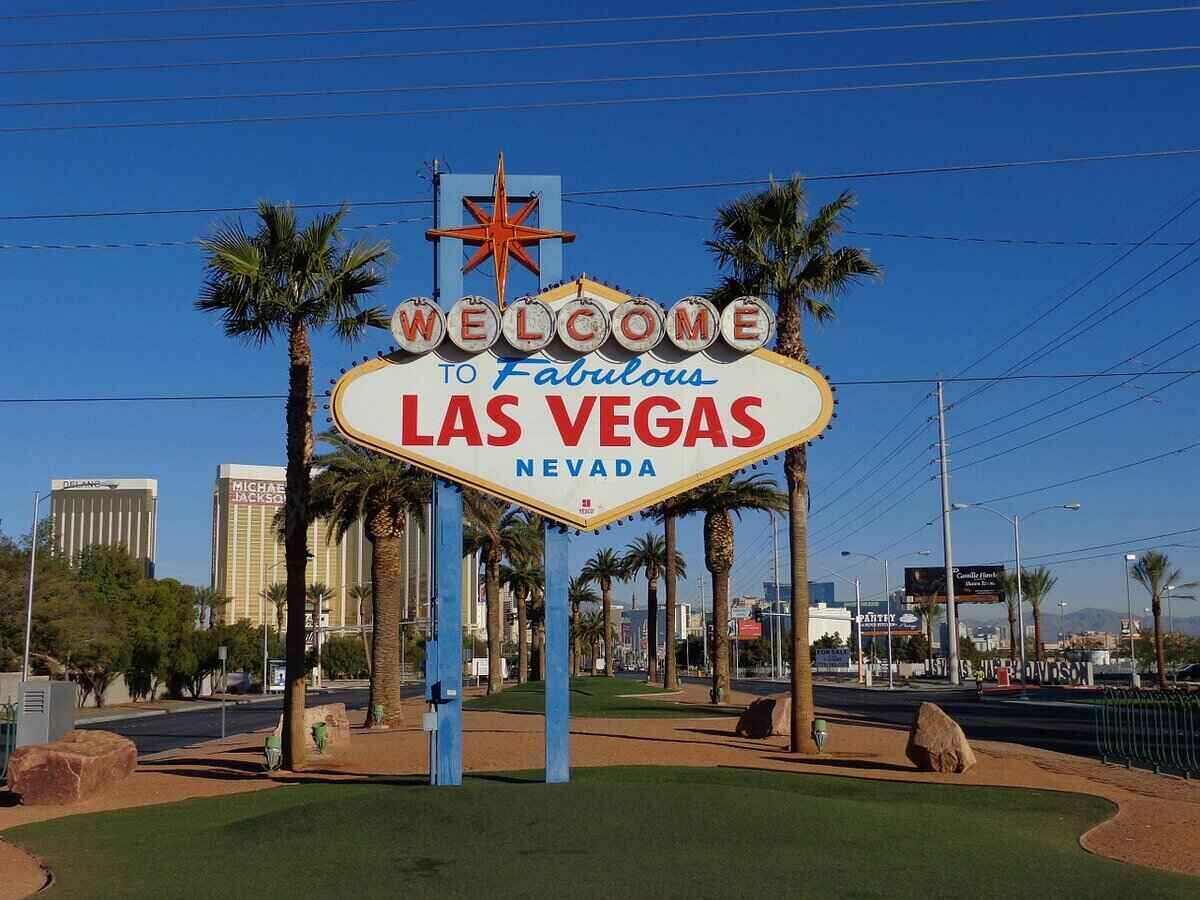
You can plant both cool-season and warm-season grasses in Las Vegas, so there are plenty of options to choose from. Your main concern is finding a type that tolerates the biggest enemy of plants in Southern Nevada: drought.
The Southern Nevada Water Authority has already taken measures to reduce water usage from lawn care. Soon, new homes in the Vegas area may not be allowed to have front lawns at all.
While you still have a lawn, you can do your part to conserve water by choosing one of the following best grass types for Las Vegas, all of which can survive hot summers on restricted watering schedules.
- Warm-season grasses
- Cool-season grasses
Las Vegas is in the transition zone
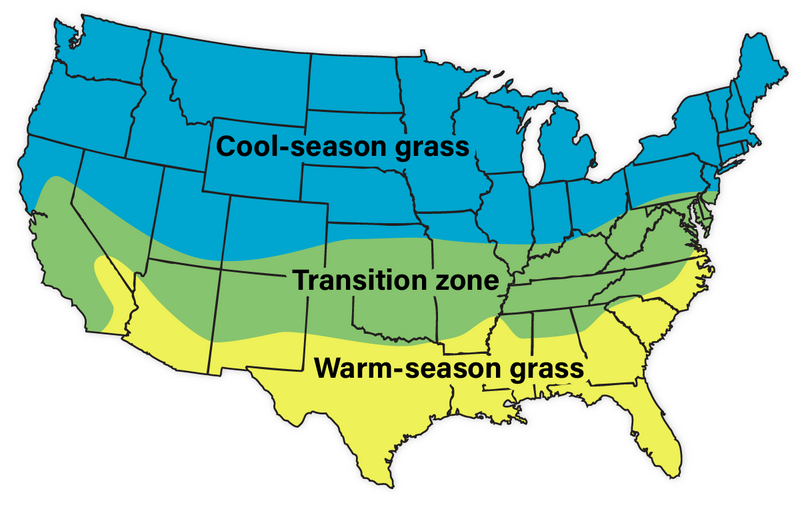
When we’re talking about grass types, there are three growing zones that determine which grasses you can grow in your area.
These are the zones:
- Warm-season zone: The southern United States, where warm-season grasses grow
- Transition zone: The middle of the United States, where both warm-season and cool-season grasses grow
- Cool-season zone: The northern United States, where cool-season grasses grow
Las Vegas sits in the transition zone, which is great news for Sin City dwellers! It means you have more choices of what type of grass to install in your yard than homeowners in any other zone.
Warm-season grasses for Las Vegas
Warm-season grass types grow actively through late spring and summer, and then they go dormant in cold weather. In Vegas, warm-season lawns typically turn brown in late fall and stay brown during winter.
1. Bermudagrass
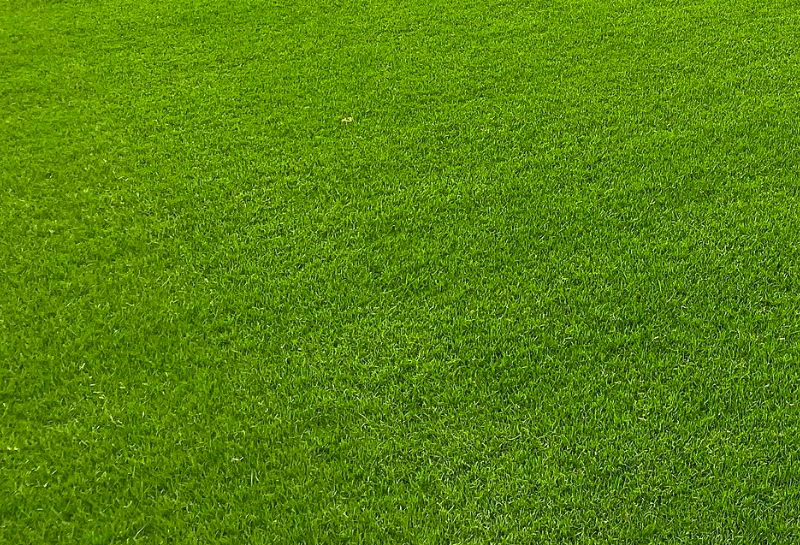
Gilba Solutions Pty Ltd | Wikimedia Commons | CC BY-SA 4.0
Bermudagrass thrives in full sun and high temperatures (sound familiar?). In summer, this grass is coarse in texture and gray-green in color. Like all warm-season grasses, it will go dormant and turn brown in the cold months of late fall through winter. While it’s dormant, Bermudagrass is fragile and easily damaged by foot traffic.
Common Bermuda spreads aggressively, which means it recovers from damage quickly but can also get out of hand and become a weed. However, there are hybrid varieties designed not to produce seeds so they don’t spread. Hybrids also tend to stay green longer each year.
- Spreads by: Above-ground stems (stolons) and below-ground stems (rhizomes); fast growth rate
- Drought tolerance: High
- Foot traffic tolerance: High traffic tolerance during active growth season; low tolerance in winter
- Shade tolerance: No shade tolerance; needs full sun
- Maintenance needs: Common Bermuda is low-maintenance, but hybrids are higher maintenance because they need more nitrogen fertilizer and more frequent mowing.
- Recommended mowing height: 1-2 inches for common Bermuda; 1-1.5 inches for hybrids
Grass Seed Options:
– Pennington Bermudagrass Bare Spot (5 lb. bag)
– Pennington Smart Seed Bermudagrass Mix (8.75-lb. bag)
– Scotts Turf Builder Bermudagrass (10-lb. bag)
– Hancock Seed Co. Bermudagrass (50-lb. bag)
2. Buffalograss
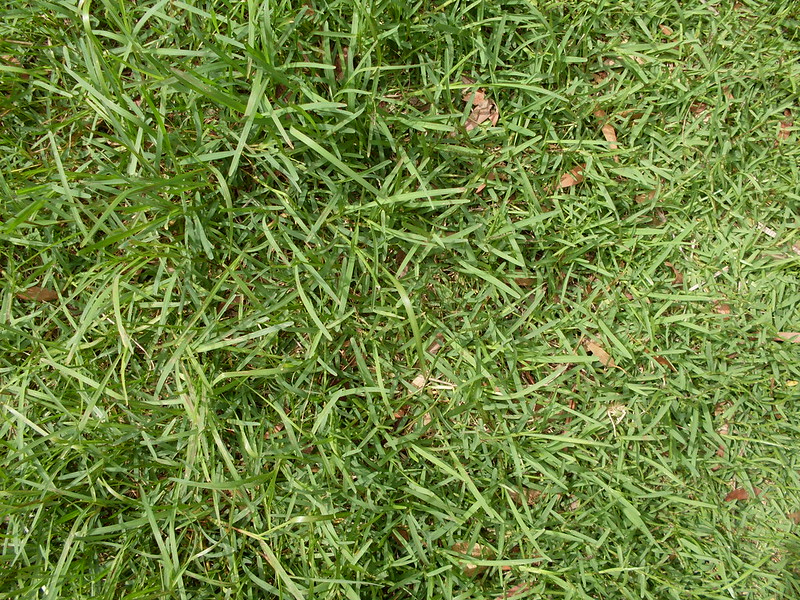
John Tann | Flickr | CC BY-SA 2.0
Buffalograss is native to the Great Plains region of North America. As a native plant, it’s low-maintenance, with minimal watering and mowing required. Buffalograss is extremely drought-tolerant and suffers more from overwatering than underwatering. It also tolerates cold temperatures better than other warm-season grasses.
In appearance, buffalograss is fine-textured and has a soft bluish-green color. Because this grass is thin, weeds often work their way in.
- Spreads by: Above-ground stems (stolons); spreads fast in summer if you water it periodically
- Drought tolerance: High; shouldn’t get more than 25 inches of water in a year
- Foot traffic tolerance: Low; not a good choice for yards with frequent, heavy foot traffic
- Shade tolerance: Low
- Maintenance needs: Low-maintenance once established but difficult to cultivate from seed
- Recommended mowing height: 1 inch in full sun or 2 inches in shade
Grass Seed Options:
– Everwilde Farms Buffalograss Seeds (1 lb. of seeds)
– Buffalograss seed (primed) (5-lb. bag)
3. Zoysiagrass
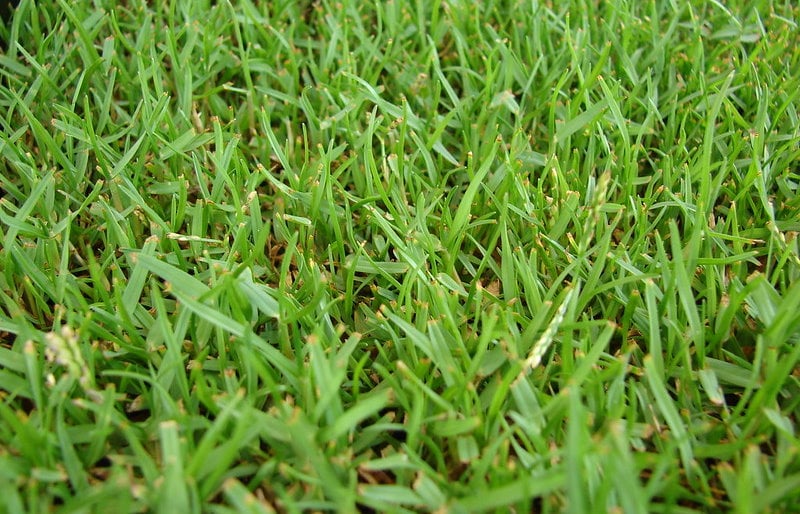
Forest and Kim Starr | Flickr | CC BY-SA 2.0
Zoysiagrass is a tough grass that tolerates shade, salt, and heavy foot traffic. It grows so densely that there’s little room for weeds to germinate, so Zoysia lawns rarely have weed problems. However, pests can be an issue without proper lawn maintenance.
- Spreads by: Above-ground stems (stolons) and below-ground stems (rhizomes); takes longer to establish than other grass types
- Drought tolerance: Moderate; turns brown and goes dormant after about a week with no water
- Foot traffic tolerance: High
- Shade tolerance: Moderate; can grow in light shade but still prefers full sun
- Maintenance needs: High; needs fertilizer throughout the year, regular irrigation during drought, and pesticide treatments to prevent lawn pests
- Recommended mowing height: 2-2.5 inches for medium- to coarse-textured varieties; some fine-textured varieties are kept below 1 inch
Cool-season grasses for Las Vegas
Cool-season grasses grow most actively in the cooler temperatures of spring and fall, and they’re more tolerant of cold winters than warm-season grasses. These grass types typically stay green year-round in Las Vegas. However, you have to water cool-season grasses regularly through summer drought to keep them from going dormant.
1. Fine fescue

Matt Lavin Flickr | CC BY-SA 2.0
There are several types of fescue grasses with fine-textured leaves, the most common of which are creeping red fescue, hard fescue, Chewings fescue, and sheep fescue. All fine fescues are tolerant grasses. They survive on little water and don’t need fertilizer unless growing in very poor soils. They can stand being cut short or growing tall. They’re also the most shade-tolerant of all the turfgrasses.
- Spreads by: Most fine fescues grow in bunches and don’t spread, but creeping red fescues spread slowly by rhizomes.
- Drought tolerance: High
- Foot traffic tolerance: Low; doesn’t perform well in areas with heavy traffic
- Shade tolerance: High; grows better in shade than any other type of turfgrass
- Maintenance needs: Low-maintenance; doesn’t require a regular fertilizing, watering, or mowing schedule to thrive and rarely has problems with pests
- Recommended mowing height: Tolerates a wide range of mowing conditions, from 1.5 to 4 inches
Grass Seed Options:
– Outsidepride Legacy Fine Fescue Grass Seed (5 lbs.)
– Eretz Creeping Red Fine Fescue Seed (choose your size)
– Outsidepride Creeping Red Fine Fescue Grass Seed (25 lbs.)
– Outsidepride Hard Fine Fescue Grass Seed (10 lbs.)
2. Kentucky bluegrass

Brenda Ryan | Lawn Love
Kentucky bluegrass (KBG for short) has a reputation for being high-maintenance, but recent observations show it’s more drought-tolerant than you would expect. It can survive on weekly watering or even less except in the hottest parts of summer. Some varieties are more drought- and heat-tolerant, and those are best for Vegas summers.
Though KBG takes more maintenance than other grass types, it’s worth the work. It forms a dense, lush lawn with an attractive dark green or blue-green color and spreads quickly by rhizomes to repair itself when damaged.
- Spreads by: Spreads quickly by rhizomes
- Drought tolerance: Moderate; needs weekly watering during drought and twice-weekly watering in the hottest part of summer
- Foot traffic tolerance: High; Withstands heavy traffic and repairs damaged spots on its own
- Shade tolerance: Usually prefers full sun, but some varieties can grow in shade
- Maintenance needs: High; needs more fertilizer, weed control, and pest control treatments than other grass types and may need more frequent watering in the height of summer
- Recommended mowing height: 2.5-3.5 inches
Grass Seed Options:
– Jonathan Green (11970) Blue Panther Kentucky Bluegrass Grass Seed (3 lbs.)
– SeedRanch Midnight Kentucky Bluegrass Seed (5 lbs.)
– Jacklin Seed – Biltmore Blue Blend – 100% Kentucky Bluegrass (5 lbs.)
3. Tall fescue

Ty Haller | Flickr | CC BY-SA 2.0
Like fine fescues, tall fescue is one of the best grasses to plant in shade. Thanks to its deep and extensive root system, tall fescue is also heat- and drought-tolerant (though not as drought-tolerant as fine fescues). As its name suggests, tall fescue prefers growing taller than other fescues. It also has broader leaves.
- Spreads by: Bunch-type grass that doesn’t spread
- Drought tolerance: High; deep roots allow for infrequent watering
- Foot traffic tolerance: High; deep roots and sturdy blades resist damage from traffic
- Shade tolerance: High
- Maintenance needs: Moderate; benefits from weekly watering, fertilizing throughout the year, and a regular mowing routine
- Recommended mowing height: 1.5-3 inches
Grass Seed Options:
– Triple-Play Tall Fescue Grass Seed Blend (5000 sq ft)
– Eretz Kentucky 31 K31 Tall Fescue Grass Seed (choose your size)
– Pennington The Rebels Tall Fescue Grass Seed Mix (7 lb.)
How to choose the right grass type for your Las Vegas yard
You can’t choose your grass just because it does well in your climate. You also have to take your yard’s specific conditions into account when making your decision. Does your lawn get a lot of shade? Do you have kids and pets running around on your grass regularly? These and other factors can result in a lackluster lawn if you don’t choose the right grass type.
Here’s a quick cheat sheet to help you decide which grass type is best for your Las Vegas yard:
- Best choices for low-maintenance: Fine fescue, common Bermudagrass
- Best choices for a shady yard: Fine fescue, tall fescue, Zoysiagrass
- Best choices for heavy foot traffic: Kentucky bluegrass, tall fescue, Zoysiagrass
Living under the shadow of drought doesn’t have to mean a brown, barren lawn in summer. You can have a lush and healthy landscape in Vegas if you choose drought-tolerant grass and plants. With smart selections, your yard can be the desert oasis of your dreams.
Don’t gamble with your lawn’s health. If you need help keeping your grass green, you can count on Lawn Love’s Las Vegas lawn care pros for mowing, fertilization, weed control, and more.
Main Photo Credit: C2GlobalSales | Pixabay
Lawn Love participates in the Amazon Services LLC Associates Program, an affiliate advertising program. Lawn Love may earn revenue from products promoted in this article.